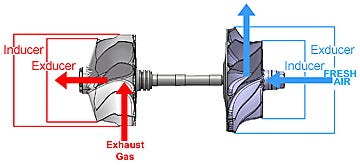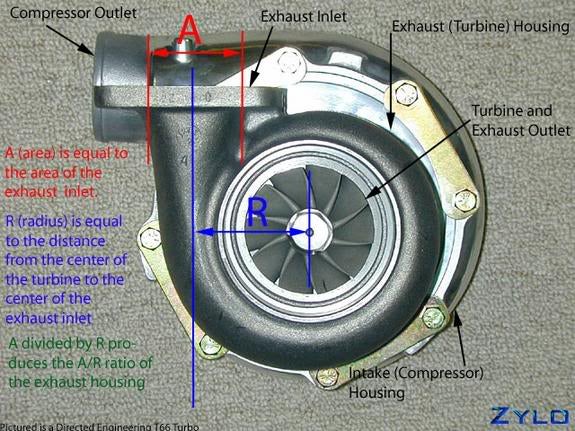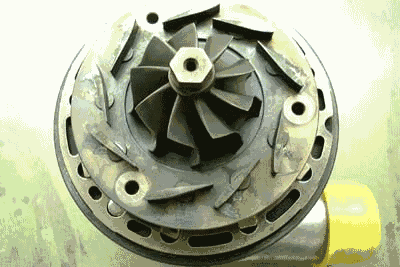 "d1ck" (d1ck)
"d1ck" (d1ck)
01/13/2014 at 15:04 • Filed to: None
 0
0
 29
29
 "d1ck" (d1ck)
"d1ck" (d1ck)
01/13/2014 at 15:04 • Filed to: None |  0 0
|  29 29 |
So I was just reading a comment here, and something struck me. People often say that a higher compression ratio will aid in spooling a turbo quicker. However I don't think this is the case at all. Increasing the CR (comp ratio) increases thermal efficiency, thus reducing waste heat produced. Turbos depend on hot gases to spool, so one would think that there would be less heat available to the turbo. Am I right?
 GhostZ
> d1ck
GhostZ
> d1ck
01/13/2014 at 15:08 |
|
A higher compression ratio means that the suction and blowing power is stronger (since the area of the cylinder at top dead center is a lot less) which increases the intake and exhaust velocity by some amount, if I remember right, which would spool up a turbo quicker. It's another one of the small, marginal improvements that a higher C/R can do.
But I also think that a better downpipe/exhaust setup or better turbo is WAY better at improving turbo spool than increasing compression ratio.
 Bluecold
> d1ck
Bluecold
> d1ck
01/13/2014 at 15:11 |
|
A higher compression ratio increases thermal efficiency by getting the temperature higher. Which makes gas expand more. Which means there is more gas pushing down your piston. And also, more gas to spool up your turbo.
In a nutshell. A very dumb nutshell, but thermodynamics is like magic to me.
 Mattbob
> d1ck
Mattbob
> d1ck
01/13/2014 at 15:13 |
|
turbos depends on gasses flowing through them that usually happen to be hot. Im fairly certain it's the mass flow of gas that spins a turbo up, not the heat. The heat is just what causes the expansion of the gasses which causes the flow in this case.
 Yowen - not necessarily not spaghetti and meatballs
> GhostZ
Yowen - not necessarily not spaghetti and meatballs
> GhostZ
01/13/2014 at 15:24 |
|
Ugh, I have to wait 2-3 weeks to get my new downpipes, haha.
 TwoFortified
> Mattbob
TwoFortified
> Mattbob
01/13/2014 at 15:30 |
|
Exactly. Yes, hot gasses spool turbos.
This gas, however, is not required to be hot (AFAIK).
 Textured Soy Protein
> d1ck
Textured Soy Protein
> d1ck
01/13/2014 at 15:31 |
|
Generally speaking, higher CR = higher cylinder temps.
 Tentacle, Dutchman, drives French
> Mattbob
Tentacle, Dutchman, drives French
> Mattbob
01/13/2014 at 15:32 |
|
Mass and speed .
A tiny high speed water jet can push as hard as a large but slow one. (This is very simplified, but enough as analogy.)
The same kind of mass (weight of the exhaust gasses) passes through, but the increased temperature gives those gasses more volume. In order to get that increased volume through the downpipe, the speed of the exhaust gasses will increase. End result? More power to spool the turbo.
 d1ck
> Mattbob
d1ck
> Mattbob
01/13/2014 at 15:58 |
|
Hotter gases have larger volume at a given pressure, which means that hotter gas will have more kinetic energy when it reaches the turbo, and the turbo can extract more energy from the exhaust gas, because it slows more as it passes through the turbine wheel.
 d1ck
> Bluecold
d1ck
> Bluecold
01/13/2014 at 16:00 |
|
What your saying sort of makes sense to me. The problem I have is that you still have the same amount of fuel to convert into heat and motion. Therefore, where does this extra heat come from?
 d1ck
> GhostZ
d1ck
> GhostZ
01/13/2014 at 16:03 |
|
How can the smaller combustion chamber directly affect the exhaust gas velocity? The velocity is dependant on the volume flow rate of the gas and the cross sectional area through which it is flowing. (exhaust port for example)
 d1ck
> Textured Soy Protein
d1ck
> Textured Soy Protein
01/13/2014 at 16:09 |
|
Higher average, or peak?
 Bluecold
> d1ck
Bluecold
> d1ck
01/13/2014 at 16:20 |
|
aaaaand my limits of thermodynamic knowledge are reached. Sorry, can't help you. You could try asking a smart person.
 Once_upon_a_pvt
> d1ck
Once_upon_a_pvt
> d1ck
01/13/2014 at 16:33 |
|
Me with no knowledge says:
Is it possible the extra heat comes from increased efficiency in the fuel burn rate due too higher compression?
 GhostZ
> d1ck
GhostZ
> d1ck
01/13/2014 at 16:33 |
|
I'm not an expert, but from what I've understood, a smaller combustion chamber (that a higher C/R would give) increases the speed of the flame front that expands outward, meaning that the velocity is slightly higher (with higher overall energy but the same mass) before it enters the exhaust port.
 Once_upon_a_pvt
> Once_upon_a_pvt
Once_upon_a_pvt
> Once_upon_a_pvt
01/13/2014 at 16:35 |
|
What I mean is maybe increasing thermal efficiency relates to burning more of the fuel in the mixture, so you gain more heat per unit of fuel. This higher burn rate expands the gasses further in the confined chamber forcing them throw the turbine faster. Same number of molecules, more volume, harder push?
Hell idk I'm drunk
 d1ck
> Once_upon_a_pvt
d1ck
> Once_upon_a_pvt
01/13/2014 at 17:19 |
|
This has more to do with the air:fuel ratio I think.
 BoxerFanatic, troublesome iconoclast.
> d1ck
BoxerFanatic, troublesome iconoclast.
> d1ck
01/13/2014 at 17:22 |
|
An incrementally higher compression ratio will make a slight difference in the energy efficiency of the internal combustion engine... but not that big of one.
Maybe it theoretically goes from ~28% efficient to ~32% efficient, or something but it doesn't make a huge swing. It certainly doesn't approach 100% energy efficiency by any stretch. internal combustion engines still put out QUITE a lot of thermal waste. (excess heat)
And unless you are dealing with direct fuel injection, raising the compression ratio increases the risk of premature auto-detonation, of the intake air/fuel charge, which is why lower compression and higher octane fuel are used in pressurized applications, such as turbocharged engines.
Don't forget that the compressor stage is pushing more air, and the fuel system is adding commensurately more fuel to the intake charge... if there is higher compression, it is more likely to auto-detonate before TDC, causing problems or even damage. the higher heat of a pressurized engine can actually heat the cylinder head to the point that the hot metal intake ports can pre-detonate even during the intake stroke, and damage intake tract parts, as well as the valve train and piston, and other involved parts.
Higher compression on a pressurized engine doesn't just add static compression like an atmospheric engine... it multiplies dynamic compression when combined with a compressed air/fuel intake charge.
Exhaust Flow is part of how a turbocharger works, but not the only part.
Pressure differential is the big part, to which flow is a factor.
But heat is also a factor, because increasing heat of a gas in a given volume also increases pressure.
The pressure differential between the input to the impeller, and it's output, matters, as well as the A/R ratio that determines the volume of the turbine impeller's housing.


As pressure builds up to the point of the exhaust inducer, the pressure change across the impeller wheel, to the lower pressure in the exhaust pipework after the turbocharger, is what causes the gas flow at the impeller wheel.
Flow that is constricted and creates too much back pressure at the inducer will cause the engine not to run well. Pressure still remains too high at the exducer, by a restrictive exhaust system behind the turbo, and the impeller wheel won't spin nearly as much, either.
And cold gas flow won't build nearly as much pressure at the inducer as hot gas-flow will... the pressure at the inducer is increased by the thermal output, even if the flow velocity is reduced while the impeller wheel is turning slowly.... that thermally-induced inducer-side pressure will accelerate the impeller wheel trying to escape to the significantly lower pressure of the down-stream exhaust system. That is what spools up a slow-turning turbocharger, not just flow rate.
 Mattbob
> d1ck
Mattbob
> d1ck
01/14/2014 at 07:09 |
|
Come back to me when you have taken thermodynamics.
 d1ck
> Mattbob
d1ck
> Mattbob
01/14/2014 at 07:13 |
|
I have. Please explain.
 Mattbob
> d1ck
Mattbob
> d1ck
01/14/2014 at 07:25 |
|
the way you worded your original statement reads as if the turbo is converting heat into mechanical energy for the purposes of compressing gasses, when it is actually using the kinetic energy of the flowing gasses. Therefore, having heat available for the turbo isn't really the point. Having overall mass airflow out of the engine is what will spool the turbo up faster. If this were the case (that a turbo converted heat), you could not run a turbo from compressed air at ambient temp. I'll give you that heat can facilitate the process, but is not the cause of it. This is getting a bit far from the original topic though, it is becoming a lot of semantics.
 d1ck
> Mattbob
d1ck
> Mattbob
01/14/2014 at 07:46 |
|
I get where you're coming from, however my point is that given two gas flows of equal mass flow rates, the hotter flow will impart more energy onto the turbine wheel due to higher kinetic energy.
 d1ck
> BoxerFanatic, troublesome iconoclast.
d1ck
> BoxerFanatic, troublesome iconoclast.
01/14/2014 at 08:24 |
|
Lots of good info here, however you didn't directly answer my question. I'm familiar with ICE inefficiencies as well as the risks of running higher compression in conjunction with forced induction. As you mentioned this risk can be controlled by use of direct injection and advanced combustion chamber design.
It's also worth noting that there is a difference between pre-ignition and detonation, but pre-ignition can often lead to detonation. It sounds like you probably know this, but I find your wording a little unclear.
The rest of your post seems to be confirming my thoughts on the matter, but you seem to have a better understanding than I do of turbine design, and I'm having a little trouble piecing it together. I believe the crux of what you're saying that that the turbine requires a gas flow rate to spin. The volumetric flow rate as well as the pressure drop across the turbine will determine how much energy the turbine extracts from the exhaust gas flow.
This is all within my understanding of the system, however I'm not really familar with the A/R Ratio. I've got to cut it off here work is calling.
 BoxerFanatic, troublesome iconoclast.
> d1ck
BoxerFanatic, troublesome iconoclast.
> d1ck
01/14/2014 at 09:24 |
|
You may be slightly right, academically, about a higher static CR using a bit more of the thermal energy inside the the internal combustion engine, leaving fractionally less waste for the turbocharger to recover, but I doubt the difference would be significantly noticeable in terms of turbine performance. Perhaps a slightly differently trimmed turbo may be in order, but there is still plenty of waste heat energy to be recovered from a higher compression direct injected engine. Especially if the intake air charge pressure is also still relatively high, as a result of not being as vulnerable to detonation, with said direct injection.
Usually increased compression ratio is part of an equation that increases kinetic power output from the system, and there is usually plenty of waste heat, even if there is a larger increase in power than the increase in wasted thermal energy... a net improvement in thermal efficiency, but also potentially an increase in thermal waste output through the exhaust.
Part of my response about heat and velocity both adding to pressure was actually partially due to other comments talking about flow velocity spinning the turbine impeller.... it isn't 'just' velocity.
A/R ratio basically is a way to calculate the volume of the turbine housing by using the diameter of the inlet, and the radius from the center of the turbine impeller out to the centerline of the inlet. Once that volume is known, it is a variable in the equation to find the pressure differential between that volume upstream of the inducer, and the volume down-stream of the exducer, the exhaust back pressure, can be calculated.
Getting the A/R value correct, basically choosing the proper size turbocharger for the application, tunes and optimizes the performance between a big housing that tends to lag at low engine speeds and low flow volumes and thermal output before pressure at the inducer builds up significantly and "spools up" the turbine. Otherwise a turbine that has too small a housing volume and impeller size can't flow at higher engine speeds with more flow volume, and basically just becomes a back-pressure impediment to the exhaust of the engine at higher RPMs.
 LandSpeed-DSM
> d1ck
LandSpeed-DSM
> d1ck
01/14/2014 at 10:05 |
|
You are correct. Greater compression does not lower the "boost threshold."
Turbine inlet temps and expansion ratios are what turbines run on. Raising compression will help bridge the gap between on and off-boost driving, but it will not spool the turbo faster.
If someone is telling you that Higher CR means greater exhaust velocity, they are absolutely mistaken.
Because it's the timing of transition from power to exhaust stroke or where you open the exhaust valve is the main factor determining the pressure and heat (waste energy) that will be leaving the chamber to perform work on the turbine wheel. The manifold plays a big role in this as well, but the CR is almost inconsequential as far as turbine operation alone is concerned.
Because even going from 7.5:1CR - 12:1CR will decrease waste heat by about 5% in practice.
 LandSpeed-DSM
> GhostZ
LandSpeed-DSM
> GhostZ
01/14/2014 at 10:12 |
|
Where you open the exhaust valve completely eclipses the effect compression ratio has on spool.
But, it is in fact the opposite of what you have posted and the OP is correct. It's a common misconception that is often passed around on forums as truth though. The fact remains: Higher CR = greater thermal efficiency, this means less waste heat to perform work on the turbine. Read up some on turbine inlet temperature, efficiency and expansion ratios.
Granted we are only discussing static CR, but the principal still applies. Displacement/RPM, Port/Chamber/Manifold design, valve event timing, post turbine back-pressure and fuel type are the biggest factors when it comes to spool. pretty much in that order.
 LandSpeed-DSM
> GhostZ
LandSpeed-DSM
> GhostZ
01/14/2014 at 10:16 |
|
The flame speed is relative to fuel composition.
Energy available is solely a function of the fuel mass and whether there is enough oxygen to combust it all. Energy cannot be created, just transferred.
Velocity of the outgoing charge will be determined by where in the transition from power to exhaust strokes the exhaust valve is opened.
 d1ck
> BoxerFanatic, troublesome iconoclast.
d1ck
> BoxerFanatic, troublesome iconoclast.
01/14/2014 at 10:55 |
|
Would I be right in saying that a variable vane turbo would change the A/R Ratio?
 BoxerFanatic, troublesome iconoclast.
> d1ck
BoxerFanatic, troublesome iconoclast.
> d1ck
01/14/2014 at 11:07 |
|
Kind of. It doesn't actually change the physical volume of the turbine housing, but it creates a similar fluid-dynamic effect as if it did, via a sort of radial vane throttle valve behavior.

It actually acts more like a variable inducer gate, making the ratio of inducer to exducer larger. The effective area of the turbine inducer is changed by exposing more or less of the turbine impeller to the pressure in the housing. The volume of the housing doesn't change much, aside from the volume that the vanes take up, but when the vanes are closed, it has an effect similar to a smaller A/R housing, as pressure builds sooner with lower volume of exhaust flow, and lower amounts of heat.
As the vanes open, the effect opens up more toward the true A/R of the housing, and the true inducer/exducer ratio, and the resistance to volume of exhaust gas flowing through the turbine is relieved, more like an inherently larger A/R turbo.
Basically it is a way for a somewhat larger turbocharger to close itself down, and build pressure to spool quickly like a small, quick-spooling turbo at low engine speeds. But it can open up and not have the drawback that small quick-spooling turbos choking at higher engine speeds with more volume of flow and pressure.
 d1ck
> BoxerFanatic, troublesome iconoclast.
d1ck
> BoxerFanatic, troublesome iconoclast.
01/14/2014 at 11:52 |
|
I assume the compressor side would experience similar efficiency problems at lower flow rates, is there a similar system that would work there?